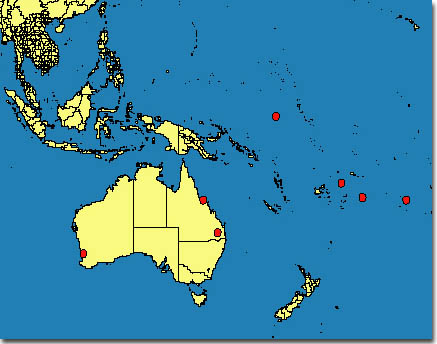 |
 |
||
|
|
|||
| Diagnosis | Encarsia lutea (Masi) |
|||||||||||||
| Species group | ||||||||||||||
| Distribution | ||||||||||||||
| Host | ||||||||||||||
| Comments | ||||||||||||||
| Illustrations | ||||||||||||||
| DNA | ||||||||||||||
Prospaltella lutea Masi, 1909: 25. Syntypes female, Italy, Campania, Portici (IEUN). Encarsia lutea: Ferrière, 1965: 132; Viggiani & Mazzone, 1979: 46; 1980: 51, Hayat, 1981: 466; 1986: 162; 1989: 48-50; Viggiani, 1987b: 155-156; Ren, 1988: 396; Polaszek et al., 1992: 384; 1999: 154-56; Viggiani & Ren, 1993: 223; Schauff et al., 1996: 21; Huang & Polaszek, 1998: 1912-1914. |
||||||||||||||
Diagnosis |
FemaleColourMesosoma yellow except pronotum, anteromedian patch on mesoscutum, axillae and propodeum largely brown and ovipositor dark brown at apex. Gaster yellow except brown at base and laterally more or less darkened. MorphologyClava 3-segmented. Antenna relatively stout , F1 almost quadrate and shorter than F2 (0.65-0.86) and F3 (0.68-0.86). Mid lobe of mesoscutum with (4-)6-8 setae. Scutellar sensilla widely separated, approximately 9 x the width of a sensillum. Distance between anterior pair of scutellar setae larger than distance between posterior pair. Fore wing 2.6-2.8 x as long as wide. Marginal fringe 0.37-0.47 x as long as wing width. Tarsus of middle tibia 5-segmented. Apical spur of middle tibia distinctly longer than half the length of the basal tarsal segment (0.73-0.87). Ovipositor 0.80-0.84 x the length of the middle tibia and 0.92-1.25 x as long as clava. Third valvula 0.34-0.38 x as long as second valvifer. MaleBody dark brown, mesoscutellar midlobe posteriorly, scutellum and legs lighter. Head brown except on top with yellow areas. Basal two flagellar segments with distinct sensorial complex, apical two segments fused. |
|||||||||||||
Species
|
Placed in E. lutea-group by Hayat (1989). |
|||||||||||||
Distribution
|
 Click here for material examined window. |
|||||||||||||
Host |
B. tabaci (Gennadius). The following additional hosts have been recorded (Chou et al., 1996; Hayat, 1989; Huang & Polaszek, 1998; Ren, 1988; Viggiani, 1987b; Yasnosh, 1989): Acaulaleyrodes citri (Priesner & Hosny), Aleurocanthus cinnamoni Takahashi, A. zizyphi Priesner & Hosny, Aleurolobus marlatti (Quaintance), A. niloticus Priesner & Hosny, A. rhododendri Takahashi, A. setigerus Quaintance & Baker, A. wunni (Ryberg), Aleuroplatus pectiniferus Quaintance & Baker, Aleurotrachelus jelinekii (Frauenfeld), A. rubi (Takahashi), Aleurotuberculatus acubae (Kuwana), A. ficicola Takahashi, A. gordoniae Takahashi, A. jasmini Takahashi, A. malloti Takahashi, A. mellastomae Takahashi, A. psidii (Singh), Aleyrodes lonicerae Walker, A. proletella (Linnaeus), Asterobemisia carpini (Koch), A. atraphaxinus (Danzig), Bemisia ovata (Goux), B. porteri Corbett, B. salicaria Danzig, Bulgarialeurodes cotesii (Maskell), Dialeurodes citri (Ashmead), D. formosoanensis Takahashi, D. kirkaldyi (Kotinsky), Pealius mori (Takahashi), P. setosus Danzig, Singhius hibisci (Kotinsky), Siphonius phillyreae (Halliday), Taiwanaleyrodes meliosmae Takahashi, Tetralicia sp., Trialeurodes abutilloneus (Haldeman), T. vaporariorum (Westwood). |
|||||||||||||
Comments |
Although morphologically rather uniform in the Australian and Pacific regions, E. lutea exhibits large colour variation in other regions (Viggiani & Ren, 1993; Huang & Polaszek, 1998) and this species group is currently being studied (Polaszek, pers. comm.). Encarsia lutea populations from Australia and the Pacific Islands differ from each other by a single point mutation (Babcock et al., 2001). |
|||||||||||||
Illustrations |
|
|||||||||||||
DNA
|
28S-D2 rDNA: GenBank Accession Code: AF254237-AF254241. |
|||||||||||||
| © Copyright 2001, CSIRO Australia |
| [webmaster - February 2001] |
| Use of this web site and information available from it is subject to our |
| Legal Notice and Disclaimer |